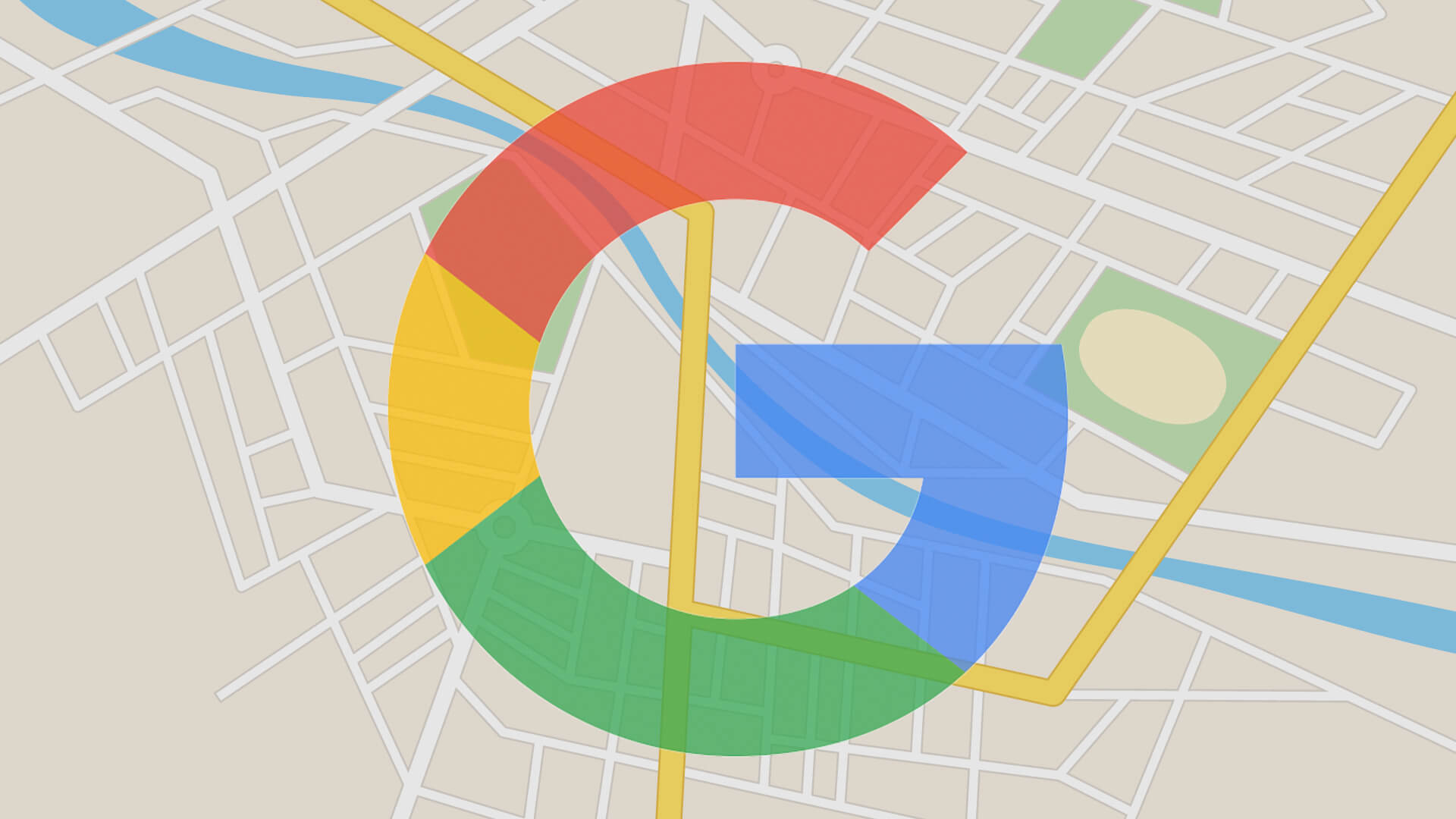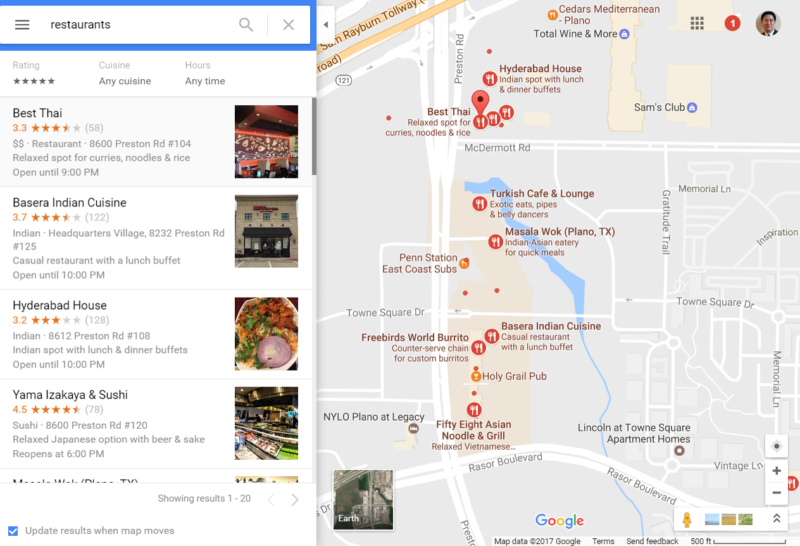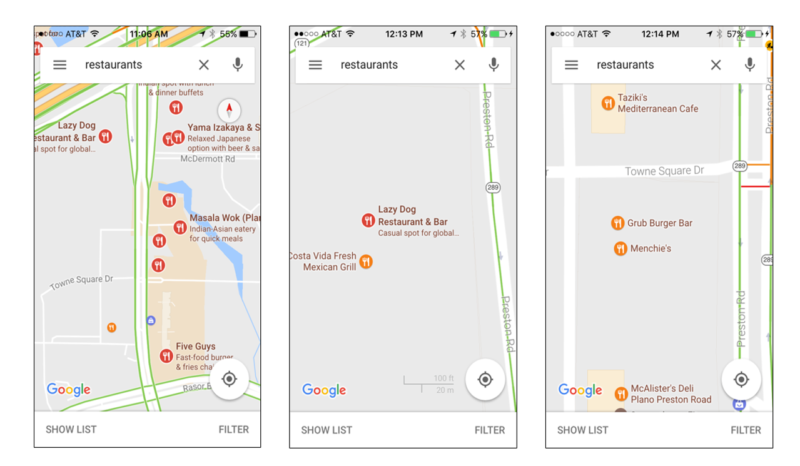
New businesses need all the help they can get to attract customers, generate revenue and establish themselves to compete with existing companies. And for brick-and-mortar storefronts, being found on Google Maps is key to driving traffic to the business.
Due to the economic explosion in the Plano and Frisco suburbs of Dallas, opening of new local stores is rampant. New commercial developments are being built and filled with shops within a matter of months. This growth also provides the ability to make some interesting Google Map search observations, as comparisons can be made between stores with similar attributes.
I’ll take a look at new restaurants located in the map area below. It’s a less-than-one-mile stretch of a busy road running north to south. The east side of Preston Road is substantially built out and has many established businesses and restaurants that have been there for several years. The west side of Preston Road is very new — all five restaurants there opened between summer and fall of 2016, with one more slated to open this spring.
As you can see, there is a marked difference in Google Map search results for the established restaurants (on the right) compared to the new restaurants (on the left — yep, you can’t see them except for one red dot).

Yet one of those new restaurants is consistently listed in Google Map results for the search term “restaurants” while the other four are not.
Below, I compare the online presence of these businesses to figure out why one shows up in results when the others don’t, and I provide five tips on how you can put your brick-and-mortar business on the map even being the new kid on the block.
The importance of Google Maps to Local Search
Eighty-four percent of consumers perform a search for local businesses. It’s no secret that mobile’s on-the-go capability is key to local search, and nearly a third of all searches performed on mobile devices are related to location. And that number is growing — local search on mobile is growing 50 percent faster than general mobile search.
Google controls 95 percen of mobile search market share. Even if you use Safari on your iPhone to search for “coffee shops near me,” Google’s snack pack results and map show up. According to comScore’s 2016 US Mobile App Report, Google Maps overtook the Google Search app for fourth place in number of unique visitors with over 95 million users. It trails only Facebook, Messenger and YouTube in unique visitors.
That means appearing in Google map results is critical for local businesses. Local search results in Google automatically pull up with a map in the snack pack, and clicking on the request for more places takes you to a Google map based results page. With 90 percent of purchases still happening offline in stores, showing up in Google Map search results is critical to local businesses being found.
The Google Maps problem facing new storefronts
You type your business name into Google Maps, and a nice red pin shows up marking your business in the right spot, and the knowledge graph with your business profile information and reviews is accurate and complete. That means searches in a local map area that match your business category will list you in results now, right? Not always, especially if you are a new business.
There seems to be a perception among SMBs that searches in Google Maps are different than those utilizing the Google search box. It makes sense and is partially true. The intent apparent through a search for restaurants located within a defined geographic area is much more targeted, and thus the results are pared down significantly from a similar search box query that might result in millions of “results.” But the belief that every restaurant on the map will show up on the list of results at some point if you kept scrolling is misplaced.
If a user hits the “next” button for more results (PC) or continues scrolling down (mobile), Google Maps often zooms out and leaves the area of original search, instead providing search results from a broader geographic area. So in my restaurant example, some within the map area are omitted from search results in favor of restaurants up to five miles away.
What made one new business shine on Google Maps
New businesses have it especially tough. About 50 percent of local search ranking factors are related to third-party recognition and interaction with your business. And because we’re talking local search, broad traditional brand reputation even from national franchise brands has limited or even negligible impact. In fact, of the five new restaurants I’m about to compare, all but one have many other locations, and the one new restaurant that consistently showed up in search results on Google Maps has the second fewest locations.
The restaurants I compare are all on the same side of the road (west) within a 1/2 mile of each other and that opened within a five-month period between July and November of 2016. I did not include Menchie’s, a frozen yogurt store. The restaurants are:
- Lazy Dog Restaurant & Bar
- Costa Vida Fresh Mexican Grill
- Taziki’s Mediterranean Café
- Grub Burger Bar
- McAlister’s Deli
Each of these restaurants has claimed their business profile, provides similar information in their knowledge graphs and has a material number of reviews. I was able to rule out the following Google profile factors as influencing ranking or impacting appearance in search results: dining style, restaurant or business category, number of months in business, number of Google reviews, quality of reviews and images included in the profile. Thus, it seems the difference lies in external signals to Google.
In a search performed in a map area along a one-mile stretch of Preston Road that includes all five of these restaurants, only Lazy Dog appeared on the map as a red dot or icon in search results. If I zoomed in, the other restaurants eventually would appear, but as orange icons instead of red. Some never showed up until I was practically on top of them in the map.

Those restaurants in red icons show up in the list of results that displays when the search is performed (I minimized the list in the above screen shots). Those in orange did not show up on the list. Instead, other more established restaurants, even farther away, appeared as I scrolled down.
Each listing contains useful information for making decisions such as food type, rating and reviews, a short description and hours of operation. Thus, showing up in the search result listing is a big advantage.
Here’s what made the difference for Lazy Dog Restaurant in appearing on the map and in the list even as a new restaurant. These lessons should apply to any business with a storefront that appears in Google Maps.
1. Claim your third-party listing profiles and make sure the information listed is accurate and complete
Sometimes it’s easy to forget that Google considers third-party data, even when it has first-hand data from you about your own business. I Googled the restaurant names to see what showed up on their SERP (search engine results page) to find what third-party data Google sees or finds.
One of the page one SERP results for Lazy Dog is its TripAdvisor page with 20 reviews. Grub Burger Bar had individual TripAdvisor reviews show up in search results, but not its main TripAdvisor listing. The TripAdvisor listing is unclaimed, even though there are 15 reviews, and Trip Advisor categorizes Grub Burger Bar as a bar and not a restaurant.
The one restaurant that performed consistently worst in my tests also had not claimed its Yelp profile, TripAdvisor profile or Community Impact (a local newspaper) profile, all of which showed up on page one of its SERP.
Inconsistencies in information or neglecting listings from authoritative sites will hurt the strength of your Google listing.
2. Post frequently on Facebook
Facebook is a valuable signal to Google, with each restaurant’s Facebook page appearing on the first page of its respective Google SERP.
Since its opening in November 2016, which makes it the newest restaurant on this list, Lazy Dog has posted a picture and a short comment on its location-specific Facebook page promoting a special offer, a dish, a drink, an event or a (usually furry) guest every single day. That kind of fresh content and engagement is a positive online signal to Google of the restaurant’s relevance and potential interest to searchers.
The one restaurant that did not have an active Facebook page consistently performed worst in the test searches I conducted. Others had fairly regular posts if sometimes inconsistent in frequency. But my tests showed that as a new business, weekly or even biweekly posts may not help enough.
3. Create location-specific content
Owners of businesses with multiple locations may believe that brand reputation as a whole helps boost search ranking of individual locations. While it might help in other areas, it does not seem to be helpful for local search.
A search for Lazy Dog Plano returns results that are almost all specific to the Plano location (with the exception of one other Yelp result). Similar searches on the other restaurants returned noticeably more results on other locations.
Thus, make sure that there’s plenty of online content that consistently mentions specific location information. For example, a restaurant can create location-specific content on sites with online menus or third-party ordering platforms. Or better, get local media to write content about your location.
4. Make it easy for local media to write about your business
Lazy Dog is the only establishment that has writeups from three well-known Plano media outlets that cover new restaurant openings. One of those writeups is also a more comprehensive article that tells a story and includes many high-quality photos.
Writers for media publishers are busy and often appreciate both ideas for content and resources that help make writing fast and easy. Providing content, stories, quotes, interesting facts and pictures in a package that is easy to digest may help get you a better-written and more complete article about your business.
5. Go deep in building your online presence
Google searches can reveal whether your location’s online presence is robust or thin. Lazy Dog gets mentions of its Plano location six pages deep in SERPs. And none of them are as insignificant as a three-comment Reddit thread that appears on page one of another restaurant’s SERP. That’s evidence Google had few options in finding relevant information on the business — not what you want.
If you look around, you’ll likely find opportunities to be mentioned online, usually for free. There are third-party listings aplenty. Do some searches on your competition and find out where they get mentioned online. Chambers of commerce, local government organizations that support business, community organizations, blogs, coupon sites, industry groups, local guides and publications all often are looking for content.
Any mention of your business in content published by these groups will help much more than an expired Reddit thread.
Closing
It’s important for new businesses to get on the map quickly, both figuratively and literally. Most of the restaurants discussed above did a decent job building their online presence, boosting their Google listing and outperforming even some of the more established restaurants on the other side of the road.
But they remained relatively obscure on Google Maps, and it is clear that with the right moves and some elbow grease, a strong online presence can be accelerated that will provide immediate returns in Google Map search results. And that superior visibility will serve a new business well in trying to establish itself.
The post 5 ways you can improve your new business’s visibility on Google Maps appeared first on Search Engine Land.